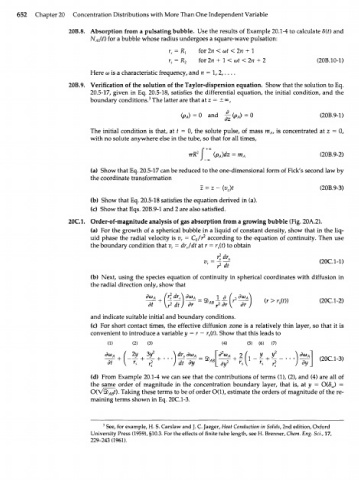Page 672 - Bird R.B. Transport phenomena
P. 672
652 Chapter 20 Concentration Distributions with More Than One Independent Variable
20B.8. Absorption from a pulsating bubble. Use the results of Example 20.1-4 to calculate 8(t) and
N (t) for a bubble whose radius undergoes a square-wave pulsation:
A0
r s = R] for In < o)t < In + 1
r s = R 2 for In + 1 < o)t < In + 2 (20B.10-1)
Here a) is a characteristic frequency, and и = 1 , 2 , . . . .
20B.9. Verification of the solution of the Taylor-dispersion equation. Show that the solution to Eq.
20.5-17, given in Eq. 20.5-18, satisfies the differential equation, the initial condition, and the
boundary conditions. The latter are that at z = ±°°,
3
(p ) = 0 and ^(Рл> = 0 (20В.9-1)
A
The initial condition is that, at t = 0, the solute pulse, of mass m , is concentrated at z = 0,
A
with no solute anywhere else in the tube, so that for all times,
l +
= m
(p
J
TTR 2 j Jp )dz )dz = A (20B.9-2)
A
A
(a) Show that Eq. 20.5-17 can be reduced to the one-dimensional form of Fick's second law by
the coordinate transformation
z = z- (v )t (20B.9-3)
z
(b) Show that Eq. 20.5-18 satisfies the equation derived in (a).
(c) Show that Eqs. 20B.9-1 and 2 are also satisfied.
20C.1. Order-of-magnitude analysis of gas absorption from a growing bubble (Fig. 20A.2).
(a) For the growth of a spherical bubble in a liquid of constant density, show that in the liq-
uid phase the radial velocity is v r = Q/r 2 according to the equation of continuity. Then use
the boundary condition that v = drjdt at r = r (t) to obtain
r s (2осы)
'>4%
(b) Next, using the species equation of continuity in spherical coordinates with diffusion in
the radial direction only, show that
and indicate suitable initial and boundary conditions.
(c) For short contact times, the effective diffusion zone is a relatively thin layer, so that it is
convenient to introduce a variable у = r - r (t). Show that this leads to
s
(1) (2) (3) (4) (5) (6) (7)
2
2y 3y 2 \ dr dw A \d (x) A 2 ( У У 2 \ д<*>А
5
д
r
А В
/ > г + г] + - " Ь ^ = ®\ 1 у 2 + s\ Ь y s + r 2 I ) У \ (20С.1-3)
эу
dt
)
д
(d) From Example 20.1-4 we can see that the contributions of terms (1), (2), and (4) are all of
the same order of magnitude in the concentration boundary layer, that is, at у = O(8J =
О(Л/2) 0. Taking these terms to be of order O(l), estimate the orders of magnitude of the re-
лв
maining terms shown in Eq. 20C.1-3.
3 See, for example, H. S. Carslaw and J. C. Jaeger, Heat Conduction in Solids, 2nd edition, Oxford
University Press (1959), §10.3. For the effects of finite tube length, see H. Brenner, Chem. Eng. Sci., 17,
229-243(1961).

